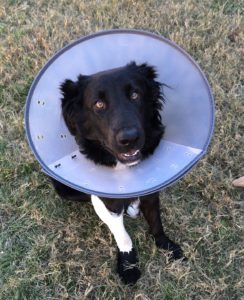As a dog parent, you probably never imagined that you’d need to have “the talk,” did you?
Hi, my name is Jennifer and we’re about to have a very serious discussion about the reproductive system… of dogs.
As dog owners, we are responsible for feeding and caring for another living animal and part of that responsibility includes getting your dog spayed or neutered or responsible breeding.
I am the dog mom to two dogs – a Yorkshire terrier named Lola and a Weimaraner named Ruger.
I adopted Ruger from a shelter and the majority of shelters spay or neuter all animals before putting them up for adoption.
So, while Ruger is neutered, Lola is not. Not yet, anyway.
She will be soon because none of us will survive another of her heat cycles. (And because it’s the responsible thing to do, of course.)
Spoiler alert: neutered dogs, such as Ruger, still hump female dogs in heat, even if the other dog is three time smaller than they are and they can’t actually do anything.
What is Neutering/ Spaying?
Spaying and neutering are the terms used for sterilizing female and male animals, respectively. The term “neutering” is often used to refer to both males and females for simplicity.
Dogs who are spayed or neutered lead longer, healthier lives. It requires a simple surgical procedure.
Your dog will generally be able to go home the same day, sporting the “cone of shame” collar and pain medicine for discomfort.
What is Neutering?
Unlike vasectomies in human males, which leave the testicles in place, male dogs are completely castrated.
That means that a small incision is made and the entire testicles are removed.
That’s why it is so easy to immediately tell the difference between intact and neutered male dogs.
What is Spaying?
When a female dog is spayed, her ovaries, and usually her uterus, are removed.
This stops not only her ability to reproduce, but also ends her heat cycles. Heat cycles are the animals equivalent to a woman’s menstruation cycle.

Female animals are also allowed to go home after the surgery is completed, wearing her own “cone of shame” to prevent licking the surgical area.
By the way, those “cones of shame” have a real name – the Elizabethan collar (E-collar.)
Pet owners call them “cones of shame” because usually, their dog has gotten into some mischief that caused the need for a trip to the vet.
While the operation is simple and quick, it should still be done by a veterinarian or a reputable animal clinic.
Why You Should Get Your Dog Neutered/ Spayed
There are many behavioral and health benefits to neutering and spaying your pups. With a female dog, heat cycles can be extremely messy and annoying, especially if you have another dog who humps her at all hours of the night when you are trying to sleep.
Neutering male dogs has shown to reduce aggressive behaviors and generally make both sexes calmer. Some undesirable behaviors that can be prevented by spaying and neutering are urine marking, humping, biting, jumping and roaming.
The most important benefit of spaying and neutering (besides reducing the number of unwanted dogs in shelters) is that it greatly improves your dog’s health and overall life expectancy.
You might be surprised to find out that male dogs are prone to testicular cancer and female dogs can get breast cancer and uterine cancer.
Spaying or neutering lowers the risk immensely. Breast cancer is actually very common in Yorkshire terriers and other small dogs. Before Lola, I had another Yorkshire Terrier. Her name was Selphie and she was my first dog as an adult.
I had no idea that dogs could even get breast cancer and I never had Selphie spayed, though the vet recommended it several times. Later in her life, Selphie did get breast cancer.
Toward the end of her life, she developed a tumor and the vet wasn’t sure if it was on her uterus or her bladder. While Selphie was undergoing surgery to remove the tumor (which luckily was on her uterus; bladder tumors are inoperable,) the vet also spayed her.
She was 14 at the time and while she did make it through the surgery, she never really recovered from it and died later that year at 15 from kidney failure.
So, while Selphie didn’t die directly from the breast cancer, the vet told me that it did weaken her immune system and made it harder to fight off the other health issues she had.
I will never forgive myself for not spaying her when the vet first recommended it and just writing this made me realize that I need to stop putting it off and get Lola spayed ASAP.
Will My Dog Be in Pain?
 During the surgery, your dog will be under anesthesia and won’t feel anything. Once they wake up and go home, they may be a little out of it from the medication.
During the surgery, your dog will be under anesthesia and won’t feel anything. Once they wake up and go home, they may be a little out of it from the medication.
You know those viral videos of people after they’ve had their wisdom teeth taken out? It’s like that, except dogs can’t talk and say funny things.
Your dog shouldn’t be in any real pain after the surgery, but there will be discomfort for at least a few days.
The bigger problem is keeping your dog calm for the seven to ten days that it takes for the incision to heal. Some dogs end up busting the stitches and needing more surgery to fix it.
That’s partly where the E-collar comes in. Its bulk at the dog’s neck prevents the dog from licking the incision. For some dogs, the e-collar can make them calmer just because it’s difficult to maneuver while wearing it.
If your dog really dislikes the collar, a lot of pet stores sell softer versions that are similar to travel neck pillows for people.
So, your dog will be in discomfort for a few days, but not in severe pain.
When Should You Get Your Dog Neutered/ Spayed?
There is a myth that female dogs should go through one heat cycle before spaying, but in the last few years, most vets have moved away from that idea.
It is now recommended to spay female dogs BEFORE they reach sexual maturity (the first heat cycle) because it helps prevent breast cancer and urinary tract infections.
For males, they can be neutered after eight months of age. However, some vets prefer to wait until the dogs have stopped growing.
They believe testosterone is linked to bone growth and a dog won’t reach their full growth if neutered, as the removal of the testicles reduces testosterone production.
How Much Does it Cost to Get Your Dog Neutered or Spayed?
 It’s difficult to give the exact cost, as vet prices vary from region to region.
It’s difficult to give the exact cost, as vet prices vary from region to region.
My vet quoted me $200 for Lola to be spayed.
Some older dogs require blood tests prior to surgery to make sure they are healthy enough to survive the surgery.
Many local humane societies offer vouchers or low-cost spaying and neutering clinics.
While the initial expense may seem like a lot, you will be potentially adding years to your dog’s life and preventing future expensive medical procedures.
If you have a more than one dog in your home, spaying or neutering your pets can help them all get along better.
Even if your dog is an only sibling, their behavior can improve as a result of the surgery.
Can a Dog Be Too Old to Get Neutered/Spayed?
People with older dogs might think the dog is too old to be spayed or neutered. I had my dog spayed when she was 14 and she made it through the surgery.
There are advanced techniques and safer anesthetic drugs that make the surgery completely safe for all dogs, regardless of age.
Some vets require blood tests for dogs that are over age seven to check kidney and liver functions necessary for anesthesia.
The benefits of spaying your older dog far outweigh any risks.
What is the Right Age for a Dog to Get Neutered/Spayed?
If you’ve just gotten a puppy, many vets agree that it is safe and optimal to spay or neuter the puppy at eight months of age.
The earlier that you spay or neuter the dog, the easier it will be for your family in the long run.
Any behavior issues or house training accidents (such as marking) can be prevented and reduced after the spay or neuter surgery.
Does Neutering/Spaying Cause Obesity in Dogs?
There is also a myth that spayed or neutered dogs will become overweight after the surgery.
Not all dogs do, but yes, it is possible. Metabolism does decrease after spaying or neutering.
However, with proper diet and exercise, your dog can maintain a healthy weight.
Final Thoughts
 Some people who want to adopt shelter dogs complain about the price. Shelters spay or neuter every animal before they allow it to be adopted AND give the dog its first vaccinations.
Some people who want to adopt shelter dogs complain about the price. Shelters spay or neuter every animal before they allow it to be adopted AND give the dog its first vaccinations.
That’s saving you about $400 right there. Adopting a shelter dog is not just a cool thing to do; it saves you hundreds of dollars in vet bills.
If you don’t want the added responsibility of deciding when and if to spay or neuter your puppy, adopt a dog from a shelter instead.
They will already have undergone the surgery and you won’t have to worry about it later.
Spaying and neutering help reduce the overpopulation of dogs while adding more years to your dog’s happy life with you.
If you have any comments or questions, please feel free to leave them below!

